Silkworms and robot work together to weave Silk Pavilion
News: researchers at MIT Media Lab's Mediated Matter group have created a dome from silk fibres woven by a robotic arm, which was then finished by live silkworms (+ movie). Update: this interview is featured in Dezeen Book of Interviews, which is on sale now for £12.
The project is intended to explore how digital and biological fabrication techniques can be combined to produce architectural structures.
The team programmed the robotic arm to imitate the way a silkworm deposits silk to build its cocoon. The arm then deposited a kilometre-long silk fibre across flat polygonal metal frames to create 26 panels. These panels were arranged to form a dome, which was suspended from the ceiling.
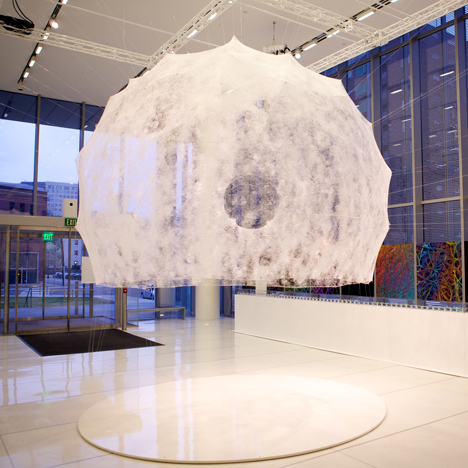
6500 live silkworms were then placed on the structure. As the caterpillars crawled over the dome, they deposited silk fibres and completed the structure.
The Silk Pavilion was designed and constructed at the MIT Media Lab as part of a research project to explore ways of overcoming the existing limitations of additive manufacturing at architectural scales.
Mediated Matter group director Neri Oxman believes that by studying natural processes such as the way silkworms build their cocoons, scientists can develop ways of "printing" architectural structures more efficiently than can be achieved by current 3D printing technologies.
“In traditional 3D printing the gantry-size poses an obvious limitation; it is defined by three axes and typically requires the use of support material, both of which are limiting for the designer who wishes to print in larger scales and achieve structural and material complexity,” Oxman told us earlier this year. “Once we place a 3D printing head on a robotic arm, we free up these limitations almost instantly."
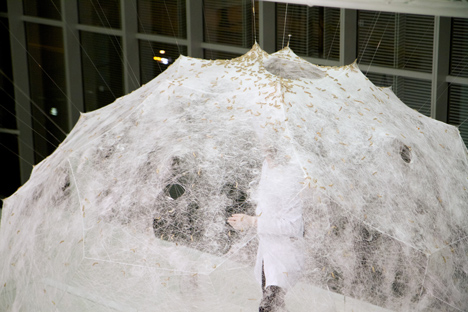
Oxman's team attached tiny magnets to the heads of silkworms so they could motion-track their movements. They used this data to programme the robotic arm to deposit silk on the metal frames.
“We've managed to motion-track the silkworm’s movement as it is building its cocoon,” said Oxman. “Our aim was to translate the motion-capture data into a 3D printer connected to a robotic arm in order to study the biological structure in larger scales.”
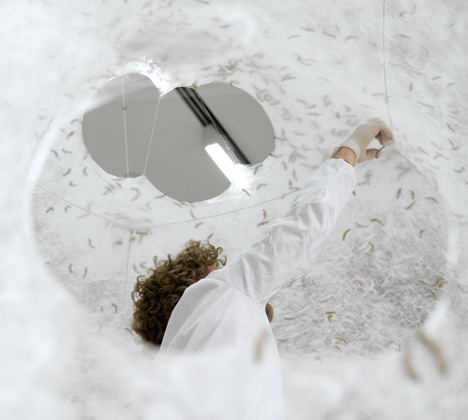
Their research also showed that the worms were attracted to darker areas, so fibres were laid more sparsely on the sunnier south and east elevations of the dome.
See our story from March this year about the research behind the Silk Pavilion. Oxman's digital fabrication work features in an article about 3D printing in architecture from our one-off publication Print Shift.
Other Dezeen stories about silk include this 2007 project by Design Academy Eindhoven graduate Elsbeth joy Nielsen, who used silkworms to weave flat silk panels, from which she made a scarf, lampshade and bath bag.
Last year, Simon Peers and Nicholas Godley wove a golden cape from silk extracted from a million wild spiders.
See more pavilion design »
See more design from MIT »
Mediated Matter Group sent us the following information:
Silk Pavilion - Mediated Matter Group at MIT Media Lab
The Silk Pavilion explores the relationship between digital and biological fabrication on product and architectural scales. The primary structure was created of 26 polygonal panels made of silk threads laid down by a CNC (Computer-Numerically Controlled) machine. Inspired by the silkworm’s ability to generate a 3D cocoon out of a single multi-property silk thread (1km in length), the overall geometry of the pavilion was created using an algorithm that assigns a single continuous thread across patches providing various degrees of density.
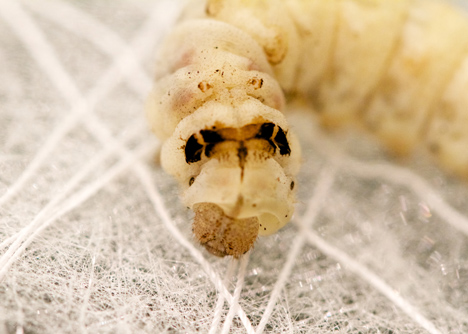
Overall density variation was informed by the silkworm itself deployed as a biological “printer” in the creation of a secondary structure. A swarm of 6,500 silkworms was positioned at the bottom rim of the scaffold spinning flat nonwoven silk patches as they locally reinforced the gaps across CNC-deposited silk fibers. Following their pupation stage the silkworms were removed. Resulting moths can produce 1.5 million eggs with the potential of constructing up to 250 additional pavilions.
Affected by spatial and environmental conditions including geometrical density as well as variation in natural light and heat, the silkworms were found to migrate to darker and denser areas. Desired light effects informed variations in material organisation across the surface area of the structure. A season-specific sun path diagram mapping solar trajectories in space dictated the location, size and density of apertures within the structure in order to lock-in rays of natural light entering the pavilion from South and East elevations. The central oculus is located against the East elevation and may be used as a sun-clock.
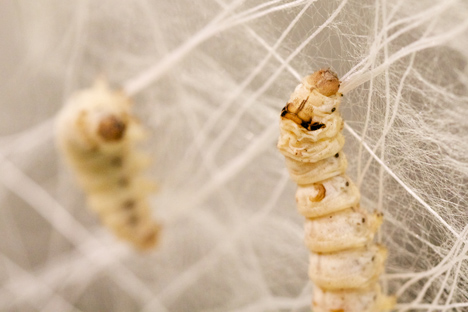
Parallel basic research explored the use of silkworms as entities that can “compute” material organization based on external performance criteria. Specifically, we explored the formation of non-woven fiber structures generated by the silkworms as a computational schema for determining shape and material optimisation of fiber-based surface structures.
Research and Design by the Mediated Matter Group at the MIT Media Lab in collaboration with Prof. Fiorenzo Omenetto (TUFTS University) and Dr. James Weaver (WYSS Institute, Harvard University). Mediated Matter researchers include Markus Kayser, Jared Laucks, Carlos David Gonzalez Uribe, Jorge Duro-Royo and Neri Oxman (Director).